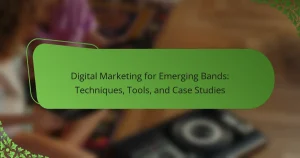Indie musicians face challenges in effectively distributing their music and reaching wider audiences. Key platforms like DistroKid, TuneCore, and Bandcamp offer various distribution options. Implementing strategic marketing and leveraging data analytics can enhance visibility and engagement. Exploring niche genres and building an online presence are crucial for success in a competitive landscape.
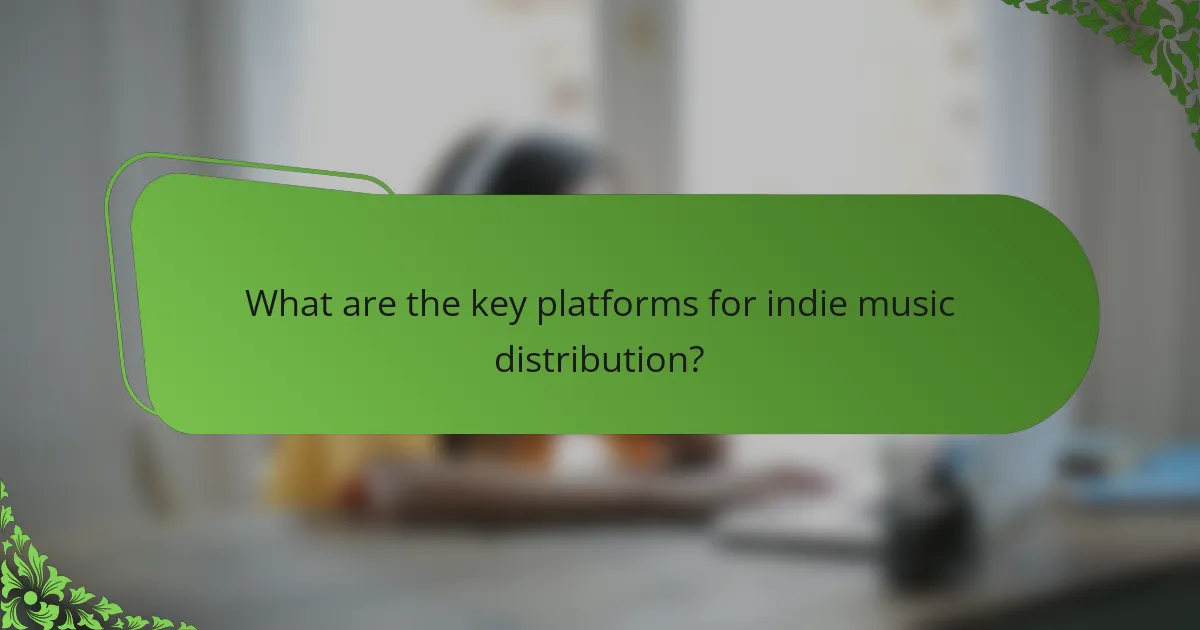
What are the key platforms for indie music distribution?
The key platforms for indie music distribution include DistroKid, TuneCore, CD Baby, and Bandcamp. These platforms enable artists to distribute their music across major streaming services and digital stores efficiently.
DistroKid offers fast distribution and unlimited uploads for a yearly fee, making it cost-effective for prolific artists. TuneCore provides detailed sales reports and allows for a pay-per-release model, appealing to those who release music less frequently. CD Baby combines distribution with physical sales options and offers various promotional tools. Bandcamp allows artists to sell directly to fans, fostering a closer connection and enabling flexible pricing.
Each platform has unique attributes that cater to different distribution needs, ensuring indie artists can find the right fit for their music career.
Which digital distribution services are most popular among indie artists?
The most popular digital distribution services among indie artists include DistroKid, TuneCore, CD Baby, and Amuse. These platforms provide essential tools for music distribution, royalty collection, and marketing support. DistroKid is known for its fast processing and low annual fees, while TuneCore offers comprehensive reporting. CD Baby provides physical distribution options, and Amuse allows artists to distribute music for free with optional premium features.
How do regional preferences impact platform choice in music distribution?
Regional preferences significantly influence platform choice in music distribution. Different regions favour specific platforms based on cultural trends, accessibility, and user demographics. For instance, artists targeting audiences in Asia may prioritise platforms like WeChat or QQ, while those in North America might focus on Spotify or Apple Music. Additionally, local regulations and market saturation can impact platform effectiveness. Understanding these regional nuances helps indie musicians optimise their reach and engagement strategies, ensuring their music resonates with the intended audience.
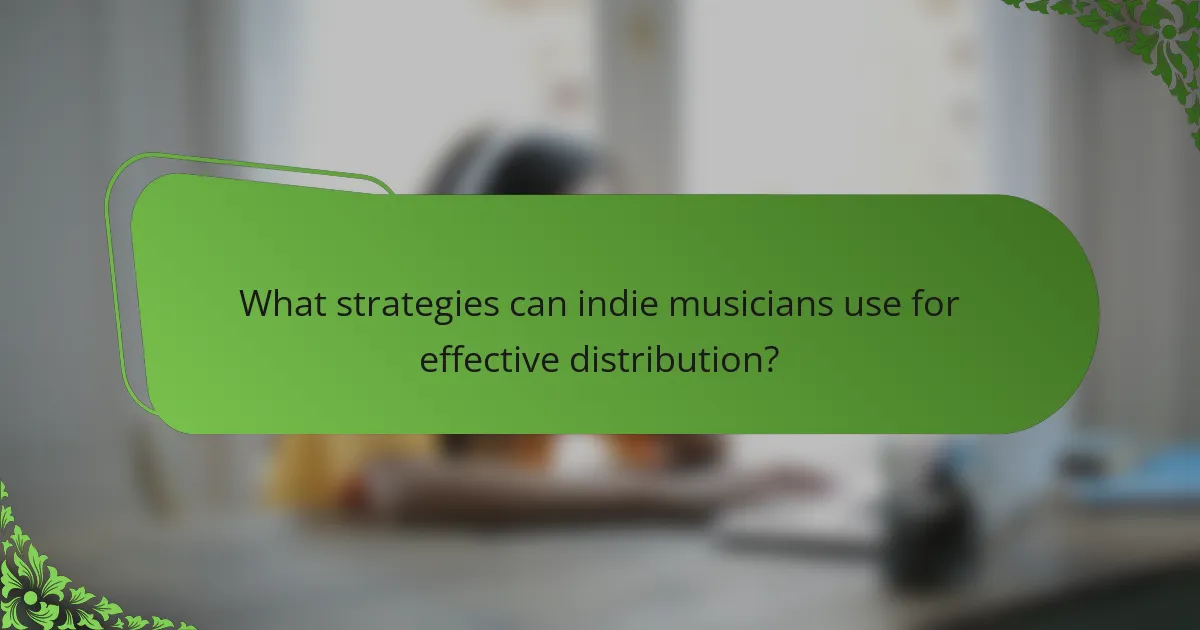
What strategies can indie musicians use for effective distribution?
Indie musicians can effectively distribute their music by leveraging digital platforms, social media, and strategic partnerships. Utilizing services like DistroKid or TuneCore ensures broad reach across streaming platforms. Engaging with fans on social media helps build a loyal audience. Collaborating with other artists can also expand visibility and access to new listeners.
How does social media influence music distribution success?
Social media significantly enhances music distribution success by increasing visibility and engagement. Platforms like Instagram and TikTok allow indie artists to connect directly with fans, showcasing their music and personality. This direct interaction fosters a loyal fan base, which is crucial for independent artists. Additionally, viral trends on social media can lead to exponential growth in streams and downloads, making it an essential tool for promotion. Engaging content, such as behind-the-scenes footage or live performances, can further amplify reach and impact.
What role does email marketing play in promoting indie music?
Email marketing is crucial for promoting indie music as it fosters direct engagement with fans. It allows artists to share new releases, tour dates, and exclusive content, enhancing listener loyalty. Regular newsletters can build anticipation and maintain interest in an artist’s work. Additionally, personalised campaigns can cater to specific audience segments, improving conversion rates for merchandise and ticket sales. By leveraging email analytics, artists can refine their strategies based on subscriber behaviour and preferences, ensuring effective communication.
Which promotional tactics yield the best results for indie releases?
Social media marketing, email campaigns, and collaborations yield the best results for indie releases. These tactics effectively reach target audiences and enhance visibility.
Social media platforms like Instagram and TikTok allow artists to engage directly with fans and share content. Email campaigns can nurture relationships and inform subscribers about new releases and events. Collaborations with other artists can expand reach and introduce music to new listeners.
Utilising these promotional tactics can significantly enhance an indie artist’s chances of success in a competitive music landscape.
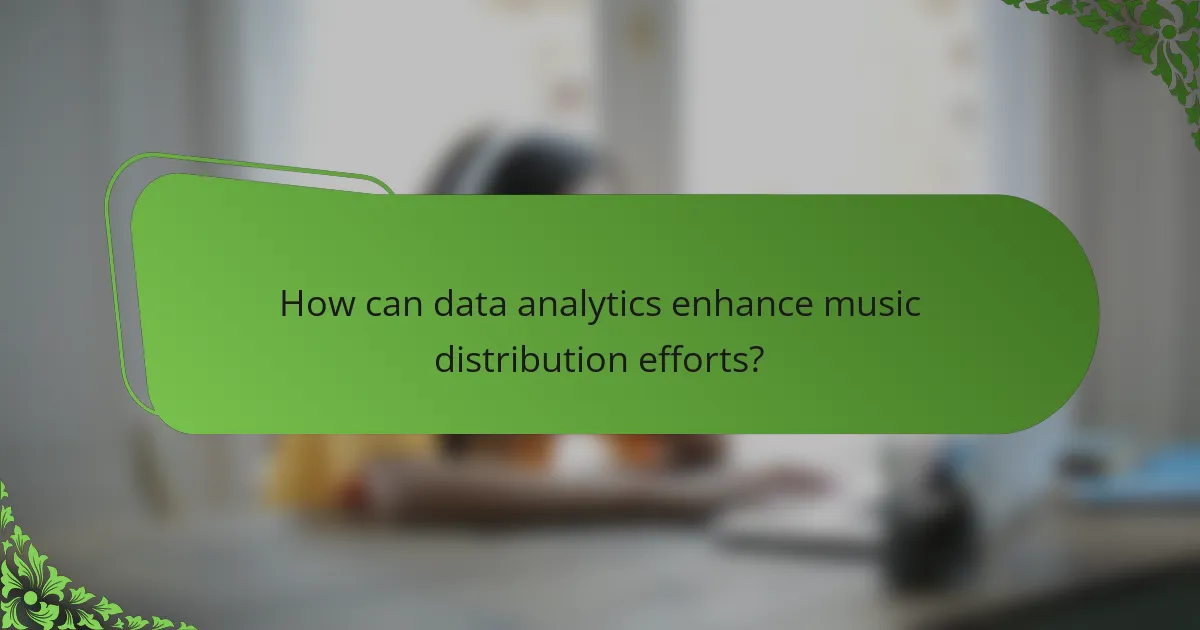
How can data analytics enhance music distribution efforts?
Data analytics can significantly enhance music distribution efforts by providing insights into audience behaviour and preferences. By analysing streaming data, artists can identify which tracks resonate most with listeners, guiding promotional strategies.
Additionally, data analytics enables targeted marketing campaigns, ensuring that promotional resources are allocated efficiently. For instance, platforms like Spotify and Apple Music offer analytics tools that track listener demographics and engagement metrics.
Moreover, insights gained from data can inform release strategies, such as optimal timing for new music launches based on listener activity patterns. This strategic approach helps indie artists maximise their reach and impact in a competitive market.
Finally, leveraging data-driven insights fosters stronger relationships with fans by enabling personalised communication and tailored content, enhancing overall engagement and loyalty.
What metrics should indie artists track for distribution success?
Indie artists should track metrics like streaming numbers, audience engagement, social media growth, and sales conversions to measure distribution success. These metrics provide insights into listener behaviour and overall reach.
| Metric | Description | Importance |
|————————-|———————————————–|————————————–|
| Streaming Numbers | Total plays across platforms | Indicates popularity and reach |
| Audience Engagement | Likes, shares, comments on music posts | Measures listener interaction |
| Social Media Growth | Follower count and engagement rates | Reflects artist visibility and appeal|
| Sales Conversions | Number of downloads and merchandise sales | Directly impacts revenue |
| Playlist Additions | Inclusion in curated playlists | Enhances exposure and credibility |
| Fan Demographics | Age, location, and preferences of listeners | Helps tailor marketing strategies |
How can streaming data inform future releases and marketing strategies?
Streaming data can significantly enhance future releases and marketing strategies by providing real-time insights into audience preferences. Analysing listener behaviour on platforms allows artists to tailor their content, optimise release timing, and refine promotional efforts. For instance, data on peak listening times can inform scheduling for singles or albums, maximising engagement. Additionally, demographic insights can guide targeted marketing campaigns, ensuring resources are allocated effectively. By leveraging streaming analytics, indie artists can make informed decisions that resonate with their audience and increase visibility.

What are the common challenges indie musicians face in distribution?
Indie musicians commonly face challenges in distribution such as limited access to major platforms, lack of marketing resources, and difficulties in navigating digital distribution channels. These obstacles can hinder their ability to reach wider audiences and monetise their music effectively.
Many indie musicians struggle with understanding the intricacies of various distribution platforms, which can lead to missed opportunities. Additionally, financial constraints often limit their ability to invest in promotional strategies that could enhance visibility.
Another significant challenge is the competition from established artists and labels, which makes it harder for indie musicians to stand out. The evolving nature of music consumption, including shifts toward streaming services, further complicates distribution efforts.
To overcome these challenges, indie musicians should focus on building a strong online presence, leveraging social media for promotion, and exploring niche distribution platforms that cater specifically to independent artists.
How can artists overcome financial barriers in music distribution?
Artists can overcome financial barriers in music distribution by leveraging affordable platforms and strategic partnerships. Utilizing digital distribution services like DistroKid or TuneCore minimises upfront costs. Collaborating with independent labels or fellow artists can also share expenses and increase reach. Additionally, crowdfunding through platforms like Patreon allows artists to engage their audience while funding projects directly. Emphasising social media for promotion can reduce marketing costs significantly. Focusing on building a loyal fanbase creates sustainable revenue streams, enhancing financial stability in distribution efforts.
What legal considerations must be addressed when distributing music?
Distributing music legally requires addressing copyright, licensing, and distribution agreements. Ensure all original works are protected under copyright law. Obtain mechanical licences for physical copies and digital downloads. Secure synchronisation licences for using music in visual media. Review distribution agreements for terms regarding royalties and rights. Consider international laws if distributing globally, as copyright laws vary by country.
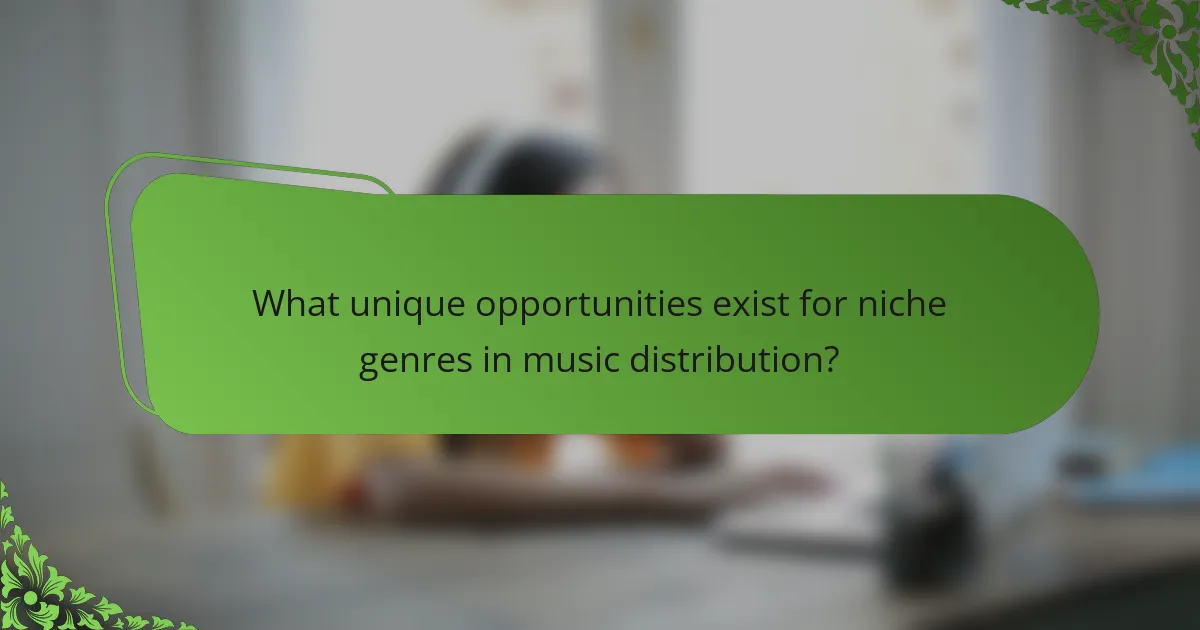
What unique opportunities exist for niche genres in music distribution?
Niche genres in music distribution present unique opportunities through targeted platforms and community engagement. Specialised streaming services cater specifically to niche audiences, enhancing discoverability. Collaborations with micro-influencers in specific genres can amplify reach. Additionally, leveraging social media groups focused on niche interests fosters direct connections with dedicated fans. These strategies allow indie artists to carve out a distinct presence in the competitive music landscape.
How can artists leverage local music scenes for broader reach?
Artists can leverage local music scenes by engaging with their communities and building relationships. Collaborating with local musicians enhances visibility and credibility. Participating in local events, such as open mics or festivals, allows artists to showcase their work and connect with potential fans. Utilizing local social media groups can amplify reach and foster a supportive network. Establishing partnerships with local venues for performances creates opportunities for exposure. Engaging with local influencers and bloggers can further promote an artist’s music. This grassroots approach often leads to a loyal fan base and broader recognition.
Which platforms cater specifically to niche markets and genres?
Platforms that cater specifically to niche markets include Bandcamp, SoundCloud, DistroKid, and ReverbNation. These platforms enable independent artists to reach targeted audiences effectively.
Bandcamp supports various genres, allowing artists to sell music directly to fans. SoundCloud focuses on emerging artists, providing a space for sharing and discovering new music. DistroKid offers affordable distribution to multiple streaming services, ideal for indie musicians. ReverbNation assists artists in promoting their music and connecting with industry professionals.
These platforms empower indie musicians to thrive in specific genres and markets, enhancing their visibility and engagement.
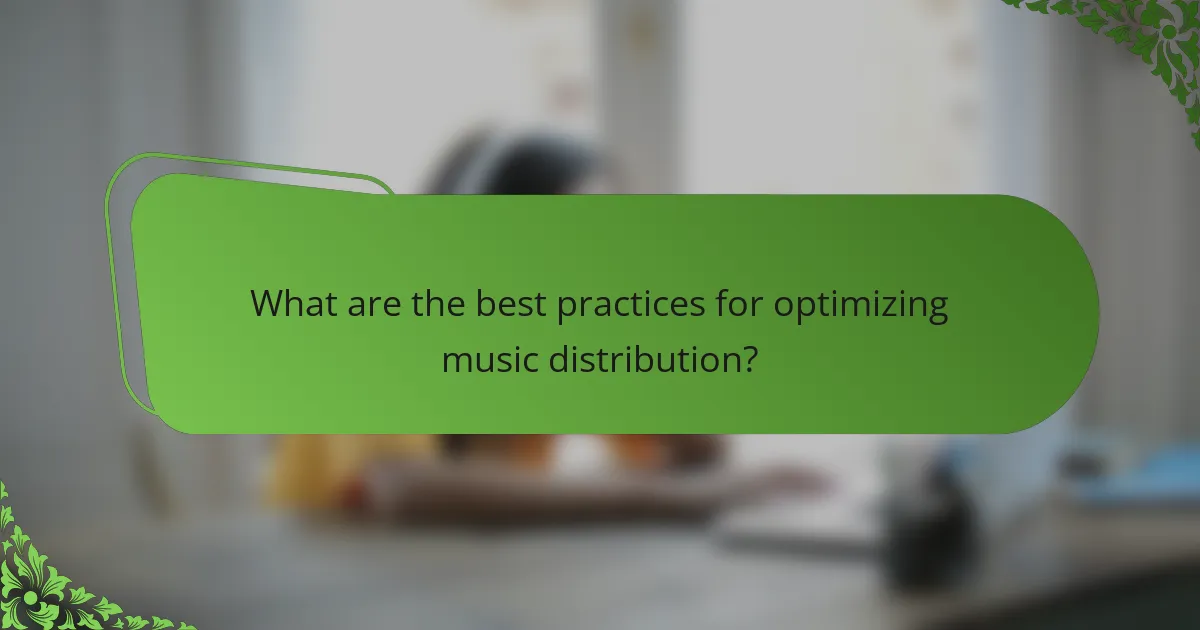
What are the best practices for optimizing music distribution?
To optimise music distribution, focus on selecting the right platforms, utilising effective marketing strategies, and analysing performance metrics.
Start by choosing platforms that align with your target audience, such as Spotify, Apple Music, and Bandcamp. Each platform has unique attributes like user demographics and distribution reach.
Implement strategies like social media promotion, email marketing, and collaborations with influencers to enhance visibility. Leverage analytics tools to track engagement and adjust tactics based on performance data.
Stay updated on industry trends and adapt your approach to maintain relevance. Engaging with your audience and building a community around your music fosters loyalty and drives long-term success.
What common mistakes should indie artists avoid in distribution?
Indie artists should avoid common mistakes like neglecting metadata, ignoring promotional strategies, and underestimating platform specifics. Properly managing these aspects enhances visibility and maximises distribution effectiveness.
1. Failing to optimise metadata can lead to poor discoverability.
2. Overlooking social media promotion limits audience reach.
3. Not understanding platform requirements may result in rejected submissions.
4. Ignoring analytics prevents informed decision-making for future releases.
5. Rushing releases without proper planning can diminish quality.
6. Disregarding copyright issues can lead to legal complications.
How can collaboration with other artists enhance distribution efforts?
Collaboration with other artists can significantly enhance distribution efforts by expanding reach and audience engagement. By partnering with artists in similar genres or styles, indie musicians can tap into each other’s fan bases, increasing visibility.
Collaborative projects, such as joint releases or shared promotional campaigns, can create buzz and attract media attention. This strategy often leads to a more effective distribution of music across multiple platforms, as combined efforts can generate higher streaming numbers and social media interactions.
Additionally, collaborations can introduce unique attributes to the music, making it more appealing to diverse audiences. This diversity can lead to rare opportunities for performances and features in playlists, further amplifying distribution efforts.
What expert tips can help maximize the impact of music releases?
To maximise the impact of music releases, focus on strategic planning and audience engagement. Utilise digital distribution platforms effectively to reach diverse listeners.
1. Build a pre-release campaign to generate buzz and anticipation.
2. Leverage social media for targeted promotion and fan interaction.
3. Collaborate with influencers or other artists to expand reach.
4. Analyse streaming data to refine future releases and marketing strategies.


